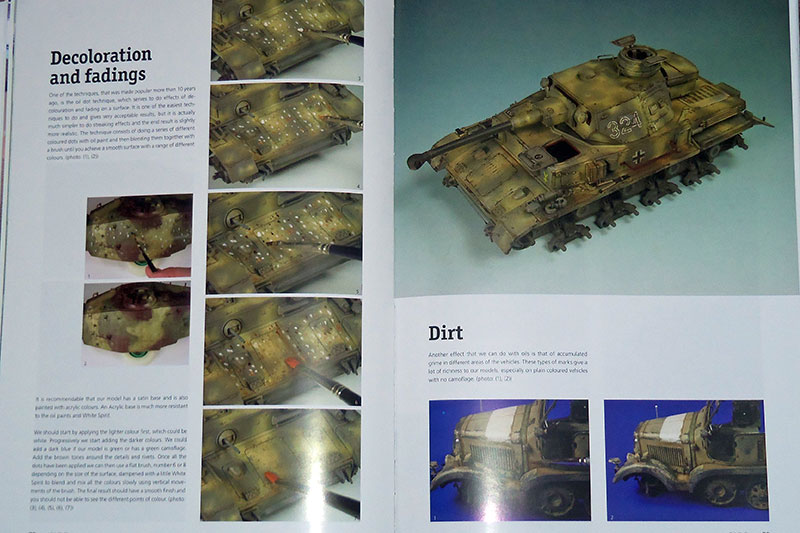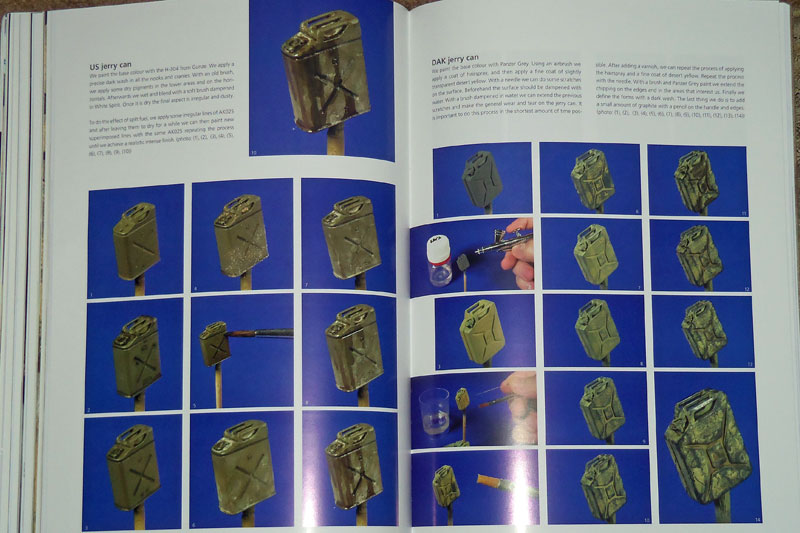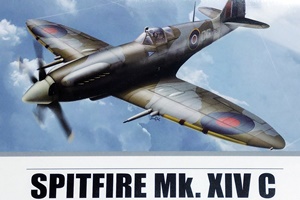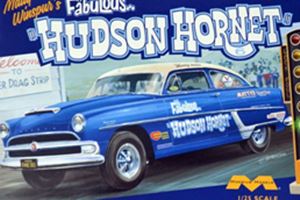Book Review:
FAQ2
Frequently Asked Questions of the AFV Painting Techniques
by Mig Jimenez, published by AK Interactive
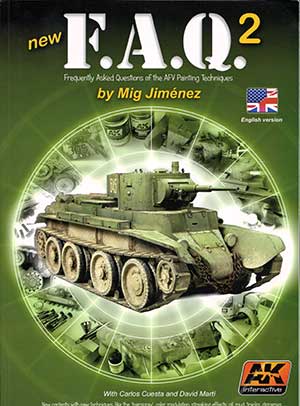 General Review:
General Review:
This is one of the most anticipated and wanted model building book to be published in the last few years. It is the second body of work by Mig Jimenez that explains in detail his AFV techniques.
The last book FAQ sold out almost as soon as it hit the shelves and has been out of print for a while. I was lucky and managed to buy mine when it came out, and I have used it to learn a lot and improve my skills.
FAQ2 is not so much as a second book in a series, but more as an updated, modernized, and more in depth look at the new techniques in AFV model building.
Mig says it best on page 19 of the book in that he states,
"The present book is not exactly the second part of the book I published over 5 years ago, as much as an update of that book. It is possible to say that FAQ1 is now obsolete, because things have changed so much."
 Content Review:
Content Review:
Now as for the book, at a list price of $79.95, it is a bit on the expensive side, on the other hand it is a fairly large book at about 8 1/2 inches wide and 12 inchs high, containing 303 pages with over 1400 photos. (I didn't count them, I got this off the AK Interactive website).
In order to try and describe what all this volume covers, I will start with an overview of the major sections.
The first five sections are the 1. Index, 2. Introduction, 3. The Evolution, 4. Changes in FAQ2, and 5. Contents (Technical Guide), after these we get down to the sections on the different techniques.
- 5.1 Materials
- The Importance of the materials
- Primers
- Acrylic paints
- Enamel paints
- Lacquer type paints
- Oils
- Specific products for weathering
- Brushes and airbrushes
- Dilutants and solvents thinners
- Auxiliary products
- 5.2 Painting Techniques
- 5.2.1 Priming
- Acrylic Primers
- Sprays
- 5.2.2 Base Colour
- Enamel and lacquer bases
- Acrylic bases
- 5.2.3 Colour Modulation
- Basic modulation
- Complete modulation
- Advanced modulation
- The effects of modulation
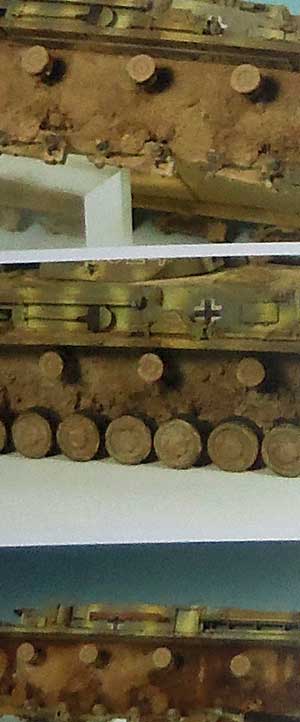 5.2.4 Panelling and Outlines
5.2.4 Panelling and Outlines
- Panelling with masks
- Outlining
- 5.2.5 Washes
- General washes
- Pin Washs
- 5.2.6 Filters
- Generic filters
- 5.2.7 Streaking Effects
- Streaking grime
- Rust streaks
- 5.2.8 Techniques using oils
- Shading and depth
- Decoloration and fading
- Dirt
- Highlights and brightness
- 5.2.9 Rain Marks
- Rain marks using enamel
- Streaking water
- 5.2.10 Hairspray Technique
- Techniques secrets
- the difference between hairspray
- and acrylic chipping fluid
- Preparation
- Chipping for Complex Camoflage
- Winter chipping
- Complete chipping effects
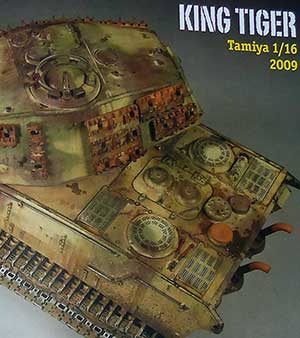 chipping effects for engines
chipping effects for engines
- 5.2.11 Chipping
- The principles of chipping
- Classic chipping using a brush
- Chipping using a sponge
- Chipping using hairspray
- Chipping using salt
- 5.2.12 Rust
- The colours of rust
- Streaking rust
- Accumulated rust
- Large areas of rust
- 5.2.13 Dust Effects
- Basic principles of dust
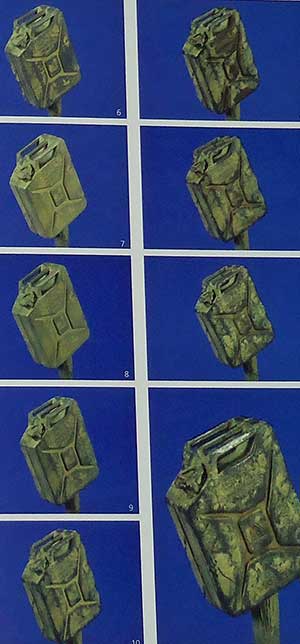 Dust on vertical surface
Dust on vertical surface- Dust effects in the desert
- Dust effects on horizontal surfaces
- 5.2.14 Mud Effects
- Dry mud
- Wet mud
- Splashed mud
- 5.2.15 Oil and Fuel
- Theory of oil
- How to apply oil
- Spilt fuel
- 5.2.16 How to Paint Tracks
- With acrylics
- Mixed method acrylic, enamel ,pigments
- Using Black n It
- Painting links
- 5.2.17 Special Effects
- Metal using graphite
- Metal using pigments
- Metal using other products
- Fallen leaves
- How to place Dry Transfers
- Headlights
- Licence plates
- Quick wheel masks
- 5.3 Paint for Accessories
- 5.3.1 The Importance of Accessories
- Vehicles own accessories
- External and ambient accessories
- 5.3.2 Painting Accessories
- How to paint Oil Drums
- How to paint Jerry cans
- How to paint a toolbox
- How to paint wooden boxes
- How to paint Helmets
- How to paint a bucket
- How to paint a MG34
- How to paint Stowage
- 5.4 Simple Dioramas
- 5.4.1 Basic Composition
- Concepts
- Composition of vignettes
- Composition in dioramas
- Groups of figures
- 5.4.2 Creating Terrain
- Modelling the terrain
- Paint, vegetation and enviroment
- Painting a building
- Diorama as a base for vehicle
- 6 Models Gallery
- 7 Conclusion
My Conclusions:
This is a must have book for any AFV Model Builder. This book will help improve your modeling skills. Although I consider my personal skill level to be a little better than average, I think this book will help me set my goals ever higher, as it inspires as well as teaches you.
There will be those that complain that Mig is trying to sell his own products as there is a lot of AK Interactives line in the book, but I think he is just showing what he uses because it works best. I must say Mig Jimenez's work speaks for itself.
Final Thoughts:
I think many will be turned off this book by its high price and maybe some by the high skill of the work shown in the examples.
But I know that most builders will want to add this to their toolbox, if for no other reason than to just look at the great photos and examples.
When all is said and done, I must say that I Highly Recommend this book to any serious builder. Get it while its out, because like the orignal FAQ, I don't think FAQ2 will stay on the shelves.
Review by Delbert
AK Interactive's Website (usa)
Sample pages:

